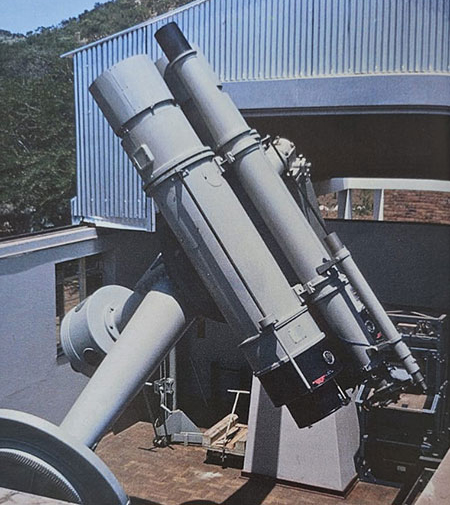by Phumla Mkize
Astronomy, geology and technology converged in a public lecture on Toppieshoek – a heritage site the Tshwane University of Technology (TUT) owns.
The lecture, themed “Stardust Sprinkled Over Humanity: Exploring the Cosmic and Human Wonders from the Cradle of Life”, was hosted by Leiden University at South Africa House in Amsterdam, The Netherlands in November.
Toppieshoek, situated in Magaliesburg, is part of the United Nations Educational, Scientific and Cultural Organisation (UNESCO) Biosphere Reserve.
It is made up of an Early Iron Age archaeological site and hosted the erstwhile Leiden Southern Station, which operated from 1953 to 1978 until the observing conditions deteriorated due to pollution.
Comprising two parts, the lecture featured two presentations, one by astronomer and Professor Emeritus at Leiden University, Prof Jan Willem Pel titled “Exploring the Southern Sky: 140 Years of Collaboration between Dutch and South African Astronomers”.
Pel was part of a delegation of researchers and astronomers from Leiden University who conducted research at the observatory located at Toppieshoek in the 1970s.
It was in the same period that proof was discovered of an Early Iron Age settlement in Magaliesburg, contradicting apartheid regime’s doctrine that there was no culture in South Africa before Europeans settled on the southern-most tip of the African continent.
Pel said until the late 19th century what astronomer found as the most interesting part of the sky, the Southern Sky, was an unknown territory.
Important developments in cataloguing the Southern Sky happened in South Africa at the Cape Observatory, the Union Observatory in Johannesburg and the Leiden Southern Station, which was housed at Toppieshoek.
“Around 1880, Kodak introduced dry photographic plates, which was the start of a technology revolution in astronomy because we could now do photography behind telescopes. [Astronomer] David Gill was one of the first to realise the importance of this,” Pel said.
“In 1882 there was a great comet … Gill photographs this very bright comet, but what he notices is the large number of very faint stars on the plates. He realises that with this technique he can photograph stars that are hundred times fainter than the faintest stars you can see with a naked eye,” he said.
According to Pel, Gill then made plans to start compiling a photographic atlas of the entire Southern Sky.
“In total the catalogue contained 500 000 million stars. The last volume was completed in 1901,” he continued.
Because it was in a coastal area, Pel said the Cape Observatory was not the best place for astronomy observations.
He added in the early 1920s, Willem de Sitter, the director of Leiden Observatory, and Robert Innes, founder and director of the Union Observatory Johannesburg, entered into a cooperation agreement to use each other’s facilities.
In 1983, the Rockefeller astrograph was installed at the Union Observatory.
“Joburg was a boom town. City smog and light pollution were a problem. Joburg astronomers went to look for a new site with less pollution. The new observatory site was the site of what is now known as Toppieshoek,” he said, adding the Franklin Adams telescope was installed there in 1957. Leiden joined the move.
The second presentation titled “Discoveries in the Cradle of Life”, was conducted by astronomer and writer Dr Lucas Ellerbroek. He explained while there were a lot of interesting cosmic developments happening in Toppieshoek in the 1970s, a lot more discoveries were made on the ground.
“Toppieshoek indicate the presence of Black Africans in the region 1 600 years ago, with evidence found of a Bantu village with rich culture and sophisticated tools; the presence of culture that has been present there for centuries,” he said about the decorated pottery, grindstones, iron slag and remains of hut floors found at Toppieshoek.
“A lot of history of the Earth is contained and can be read as a history book in the landscape of Magaliesburg.
“Close to the reserve is the Vredefort crater, one of the biggest crater remains found on Earth. It was hit by an asteroid which was 10 to 15km in size, much bigger than the one that killed the dinosaurs 67 million years ago. It is one of a few remains of that period in the Earth’s history,” he said.
“There was big volcano that eroded the landscape and the whole continent shifted,” he said.
On 9 March 2024, the Vice-Chancellor and Principal, Professor Tinyiko Maluleke, unveiled a Blue Plaque of the two national heritage sites at Toppieshoek. TUT is contributing to conserving and promoting these priceless sites.

TUT Vice-Chancellor and Principal, Prof Tinyiko Maluleke, unveiled a Blue Plaque of the two national heritage sites at Toppieshoek on 9 March 2024. The Rockefeller Twin Astrograph in operation at Hartbeespoort in 1974. (JW Pel)
